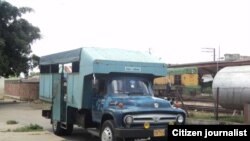The last Council of Ministers in Cuba publicly acknowledged that public transportation "for years has been unstable, insufficient and of poor quality" throughout the island.
Such recognition may be news for ministers and senior government officials, but it’s been the daily bread, throughout the country for many years, for the average Cuban, who depends on public transportation as the only means to get around.
When the Soviet Union maintained the Cuban economy, there were 15,800 buses for public service throughout the island, but when the subsidies ended in the mid 90’s public transportation decreased to less than 1,500 buses.
Currently, the bus terminal is equipped with 7,840 vehicles, with over 40 different makes and models, for the nearly 12 million people that live in Cuba. More statistical figures are published at the official site, CubaDebate.
Official propaganda claims that passenger transportation is an essential part of the process of updating the Cuban economic model and has therefore been endorsed in the Guidelines of the Economic and Social Policy adopted at the Sixth Party Congress.
Further details include information about a manufacturing program for the “semiómnibus" which is built from trucks parts and adapted to accommodate passengers for the purpose of transportation.
But the lack of government resources and the inefficient level of production has forced the transportation authorities to allow individuals in the private sector to work as carriers, particularly in the countryside where the lack of public transportation is more precarious.
According to Mariano Fernandez, Transport Minister and delegate in the province of Camagüey, there are more than 5,000 small business owners providing transportation services in this particular area. These “cuenta propistas” or self-employed business owners, "help ease the difficulties of public transport in the region."
The blog “Desde el valle cubiteño,” written by journalists from Cubitas Radio reports that in Camagüey, the second largest city in Cuba, there are 30 privately owned trucks in circulation as well as an additional 20 state owned buses to respond to the demand of a population of over 300,000 inhabitants.
Such recognition may be news for ministers and senior government officials, but it’s been the daily bread, throughout the country for many years, for the average Cuban, who depends on public transportation as the only means to get around.
When the Soviet Union maintained the Cuban economy, there were 15,800 buses for public service throughout the island, but when the subsidies ended in the mid 90’s public transportation decreased to less than 1,500 buses.
Currently, the bus terminal is equipped with 7,840 vehicles, with over 40 different makes and models, for the nearly 12 million people that live in Cuba. More statistical figures are published at the official site, CubaDebate.
Official propaganda claims that passenger transportation is an essential part of the process of updating the Cuban economic model and has therefore been endorsed in the Guidelines of the Economic and Social Policy adopted at the Sixth Party Congress.
Further details include information about a manufacturing program for the “semiómnibus" which is built from trucks parts and adapted to accommodate passengers for the purpose of transportation.
But the lack of government resources and the inefficient level of production has forced the transportation authorities to allow individuals in the private sector to work as carriers, particularly in the countryside where the lack of public transportation is more precarious.
According to Mariano Fernandez, Transport Minister and delegate in the province of Camagüey, there are more than 5,000 small business owners providing transportation services in this particular area. These “cuenta propistas” or self-employed business owners, "help ease the difficulties of public transport in the region."
The blog “Desde el valle cubiteño,” written by journalists from Cubitas Radio reports that in Camagüey, the second largest city in Cuba, there are 30 privately owned trucks in circulation as well as an additional 20 state owned buses to respond to the demand of a population of over 300,000 inhabitants.




